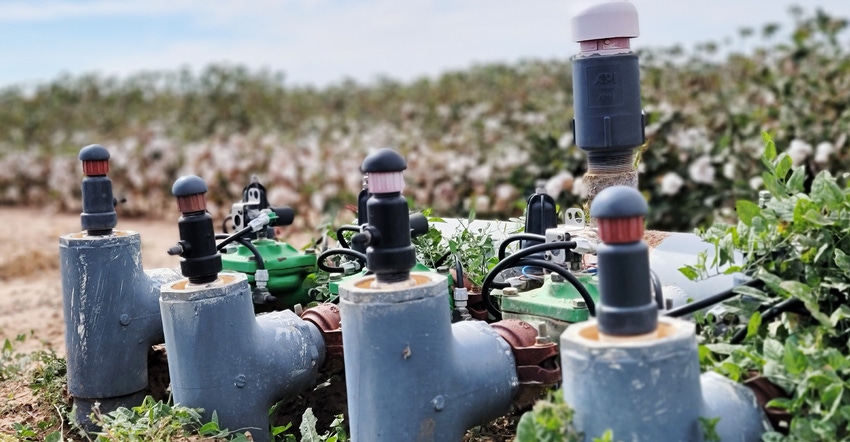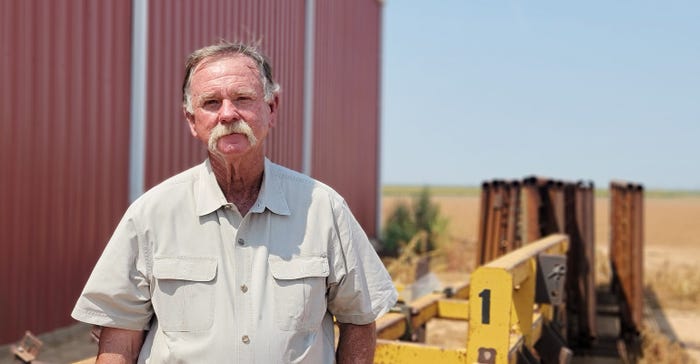
*Part 1 of a four-part series on irrigation and water management.
No silver bullet exists to help every Texas High Plains farmer who irrigates cropland save water. But resources are available, says Rick Kellison, project director for the Texas Alliance for Water Conservation in Lubbock.
“All the growers I know face a declining resource but are doing the best they can to utilize that resource as judiciously as they can,” Kellison says.
 Rick Kellison, project director for the Texas Alliance for Water Conservation in Lubbock. (Photo by Shelley E. Huguley)
Rick Kellison, project director for the Texas Alliance for Water Conservation in Lubbock. (Photo by Shelley E. Huguley)
“We need to use water judiciously, especially for irrigation, to make sure we get the most production we can.”
Production per water unit
He says producers need to consider the yield achieved for every unit of water. “If we don’t get to the top end of the yield curve, we waste water.”
He sees room for improvement. “Every year is different but often we can save water on the tail end of the growing season. We used to think we would be done by late August, then by September 10, and lately not until the end of September. I think we may be seeing a tradeoff for cotton pounds but a loss in quality.”
He says the most profitable return might not be the maximum yield.
Weather factors
“Conditions after the final water application make a difference,” Kellison says. “Will it be warm enough to boost yield? Academia can help with that through research.”
Part of that research has involved moisture sensing.
He says Texas Tech, which oversees TAWC, has been working with growers over the last few years to help them learn how to use soil moisture sensing technology. One issue he says farmers have expressed is that technology changes so fast they can’t keep up with it.
“At TAWC, we’ve used every brand of capacitance probe available. We want to show producers how to use them. We have the technology and can teach producers how to retrieve data, but it takes experience to have faith in the numbers.”
He says research at the Texas A&M Research Center at Halfway, Texas, as well as research at Texas Tech, shows that soil can’t store as much water as initially thought. “We’ve also done work to determine the optimum time to apply water to cotton.”
On-farm project
He says one TAWC on-farm project includes several styles of irrigation delivery — LISA, LEPA, subsurface drip, and varied row spacings for pivot systems.
“The irrigation circle is as uniform as any in the Panhandle for soil type. Research can show the difference in water infiltration and movement of water beneath the soil surface.
“Drone shots allow growers to see the wetting pattern form above. That’s something we use as a teaching tool.”
Confidence
Confidence in the data is crucial, Kellison says. “Third-party verification is common among farmers who look for actionable information. For as long as I’ve been in the agriculture service industry, I’ve seen that even some of the most astute producers use third-party verification — Extension, consultants, or industry reps — someone they trust. One thing the industry needs now is more trained folks in the field to help producers.”
He says TAWC is a catalyst for Texas Tech to consider that need.
“COVID-19 put us behind, but we have an ag water management certification program for undergraduates in any department in the College of Agriculture. Students are required to take 15 hours to earn the certificate.
“I am most excited about a seminar class, offered one semester a year, that brings in consultants, industry representatives, and producers to meet students and discuss specific areas of expertise. Internships are available for some students to allow them to test the water in different areas.
“The program trains students to be more prepared and ready to hit the ground running when they graduate and become employed. I believe we can do a better job preparing students to be more productive employees when they start.”
Constant change
Kellison says conditions change every year. With a more ideal growing season, we see less impact from water use efficiency. In 2011, with LEPA on 80-inch centers, we made $100 more per acre with that system compared to other types on the same amount of water.
“Over time, we want to find the best methods. We have to think 20 to 25 years down the road to determine what we will need. We want to find out how producers who are surviving are doing. How do they succeed?”
See Part 2, Water management technology: Is it a fit?
About the Author(s)
You May Also Like






